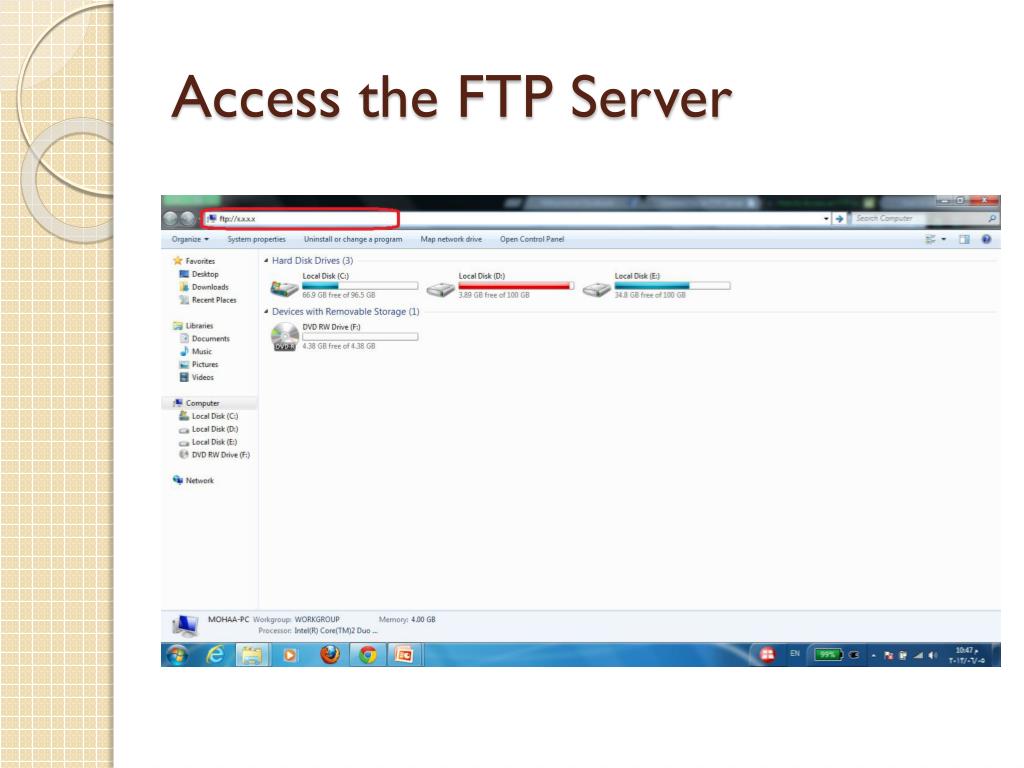
- ANDROID FTP SERVER WRITE ACCESS EXTERNAL STORAGE PORTABLE
- ANDROID FTP SERVER WRITE ACCESS EXTERNAL STORAGE ANDROID
- ANDROID FTP SERVER WRITE ACCESS EXTERNAL STORAGE CODE
Each object will represent a private application-specific directory on all shared/external storage devices where the application can place the files it owns.

The method (string type) will return an array of Java.IO.Files. The string values are available through constants on the Android.OS.Environment class: Android.OS.Environmentįor devices that have multiple external storage partitions, each partition will have a directory that is intended for private files. This is a directory intended to provide a standard location for a logical organization of files. The parameter for GetExternalFilesDir() is a string that specifies an application directory. This document will refer to the storage directory for private files on external storage as PRIVATE_EXTERNAL_STORAGE. As an example, for an application with the package name, the "root" directory of the private external files would be: /storage/emulated/0/Android/data//files/ Passing null to this method will return the path to the user's storage directory for the application. This method will return a Java.IO.File object that represents the private external storage directory for the app. The primary location for private external files is found by calling the method (string type). Similar to internal files, these files will be deleted when the app is uninstalled by the user. Private external files are considered to be specific to an application (similar to internal files) but are being kept on external storage for any number of reasons (such as being too large for internal storage). These are the same APIs that are discussed in the section on reading and writing. NET APIs are used to read and write to these files.
ANDROID FTP SERVER WRITE ACCESS EXTERNAL STORAGE ANDROID
Android provides two different APIs for resolving the paths to private and public files, but otherwise the same. Private files are private in the sense that they are considered to be a part of the application, while public files are any other files that exist on external storage. The differences between these files is primarily conceptual. Public files – These are files that are not considered to be specific to the application and are meant to be freely shared. Even though the files are called "private", they are still visible and accessible by other apps on the device, they are not afforded any special protection by Android. Android expects that private files are stored in a specific directory on external storage.

Private files – Private files are files that are specific to your application (but are still world-readable and world-writable). There are two different types of files that an app may keep on external storage: Public and private files on external storage This guide will discuss the concepts and APIs in Android that are specific to external storage. Instead, Xamarin.Android exposes the native Android APIs that will help with determining the path to files on internal and external storage.
ANDROID FTP SERVER WRITE ACCESS EXTERNAL STORAGE CODE
Because the actual paths to internal and external storage may vary from device to device or from Android version to Android version, it is not recommended to hard code the path to the files. The Xamarin.Android app determines the path to the file that will be manipulated, then uses standard. Reading and writing to files is almost identical in Xamarin.Android as it is to any other. The files for all users are still world-readable and world-writeable however, Android will sandbox each user profile fromthe others. Apps running as one user will not have access to files from another user on the device. On devices that have multiple users, each user will have a dedicated directory on the primary external storage partition for their external storage. All of these partitions are treated by Android as external storage. For example, an Android tablet (in addition to its internal storage) might have emulated storage and one or more slots for an SD card. Alternately, some Android devices may have multiple external storage partitions. This is known as emulated storage and is still considered to be external storage. Instead some devices will allocate some of their internal non-volatile memory to Android which can perform the same function as removable media. This distinction is no longer as relevant as Android devices have evolved and many Android devices no longer support removable storage.
ANDROID FTP SERVER WRITE ACCESS EXTERNAL STORAGE PORTABLE
Historically speaking, external storage referred to a disk partition on removable media such as an SD card (was also known as portable storage). The primary purpose of external storage is to provide a place to put files that are meant to be shared between apps or that are too large to fit on the internal storage. External storage refers to file storage that is not on internal storage and not exclusively accessible to the app that is responsible for the file.


 0 kommentar(er)
0 kommentar(er)
